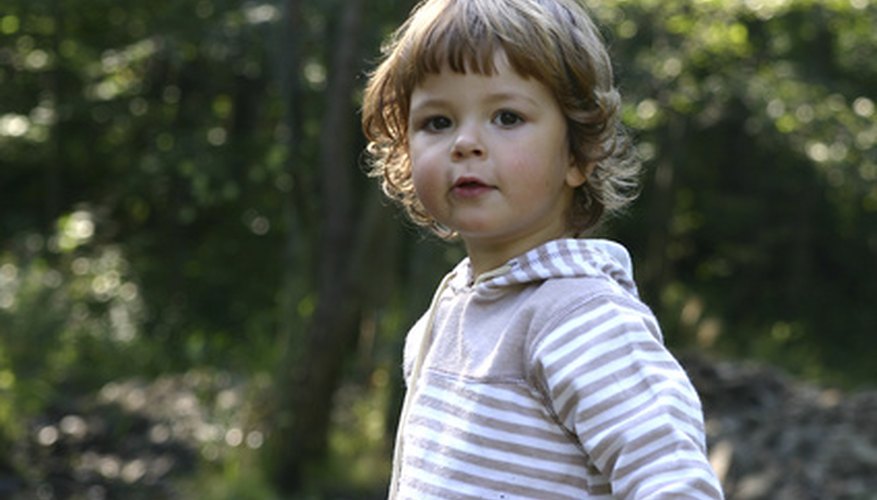Roger Brown was an eminent social psychologist, best known for his studies in early linguistic development of children. He described five stages of language development, based on the mean length of utterance (MLU), which is the number of morphemes --- basic units of meaning --- toddlers can produce. For example, jump is one morpheme, indicating the action, while jumped is two, indicating both the action and past tense.
Stage I
Early in stage 1, from 12 months of age to 26 months, children will be able to connect the agent with an action and an action with an object; for example, they can say dad walk, give ball. A simple no is used for negation. For a series of objects they just name them, without using connectors. From 22 months of age to 26 months, the late part of Stage I, they can form complete subject-verb-object sentences, use no and not interchangeably, connect words with and, while learning the present progressive -ing, to say Mom cooking, for instance. Prepositions in and on also appear.
- Early in stage 1, from 12 months of age to 26 months, children will be able to connect the agent with an action and an action with an object; for example, they can say dad walk, give ball.
Stage II
The second stage occurs between 27 and 30 months of age, when children learn the meaning and how to use gonna, wanna and other embedding. Copula start appearing, as well as don't and can't in negative sentences, while the negative element is placed between the subject and the predicate. In interrogative sentences, an early inversion makes its appearance, in what and where sentences. Children will have learnt how to use in and on prepositions, while during this stage, they will start using regular plurals, as well as irregular past, such as fell and ran.
- The second stage occurs between 27 and 30 months of age, when children learn the meaning and how to use gonna, wanna and other embedding.
- Children will have learnt how to use in and on prepositions, while during this stage, they will start using regular plurals, as well as irregular past, such as fell and ran.
Stage III
Between the age of 31 and 34 months, children will start using the auxiliary verbs both in declarative and interrogative questions. In addition, auxiliary verbs will appear with copula in the later parts of the stage. Children will start using conjunctions such as if, so, or and but. Won't will start appearing in negative sentences. Possessives, articles and regular past should have been used regularly by kids at this stage.
- Between the age of 31 and 34 months, children will start using the auxiliary verbs both in declarative and interrogative questions.
- In addition, auxiliary verbs will appear with copula in the later parts of the stage.
Stage IV
During the fourth stage, between 35 and 40 months of age, double auxiliary verbs will appear in declarative sentences. Children will use such verbs in negative sentences too, while adding isn't, aren't, doesn't and didn't to their vocabulary. In interrogative sentences, they will be able to invert the copula and subjects in polar (yes/no) questions, as well as do the auxiliary verb --- subject inversion. When and how will also appear in answers. Embedded why questions and infinitive phrases at the end of sentences will also appear, as well as because, to express cause and effect.
- During the fourth stage, between 35 and 40 months of age, double auxiliary verbs will appear in declarative sentences.
- In interrogative sentences, they will be able to invert the copula and subjects in polar (yes/no) questions, as well as do the auxiliary verb --- subject inversion.
Stage V
Between 41 and 46 months of age, the indirect object will make its appearance in sentences. Children will start using wasn't, wouldn't, couldn't and shouldn't. Tag questions will start appear, such as "He is tall, isn't he?" Children will start using relative clauses to connect very simple sentences, while three clause declaratives will appear. By now the regular third person and the irregular third person will be easily used.
- Between 41 and 46 months of age, the indirect object will make its appearance in sentences.
- Children will start using relative clauses to connect very simple sentences, while three clause declaratives will appear.
Stage V+
After the age of 4, children will add the indefinite forms nobody, nothing, none and no one in negative sentences, but will still have problem with double negatives. Gerunds will also appear during this stage, as well as embedding and conjoining within the same sentence. Kids will also extend the use of clausal conjoining in their speech. In addition, contractible auxiliary, such as dad's sleeping, will be widely used by children of this age.
- After the age of 4, children will add the indefinite forms nobody, nothing, none and no one in negative sentences, but will still have problem with double negatives.
